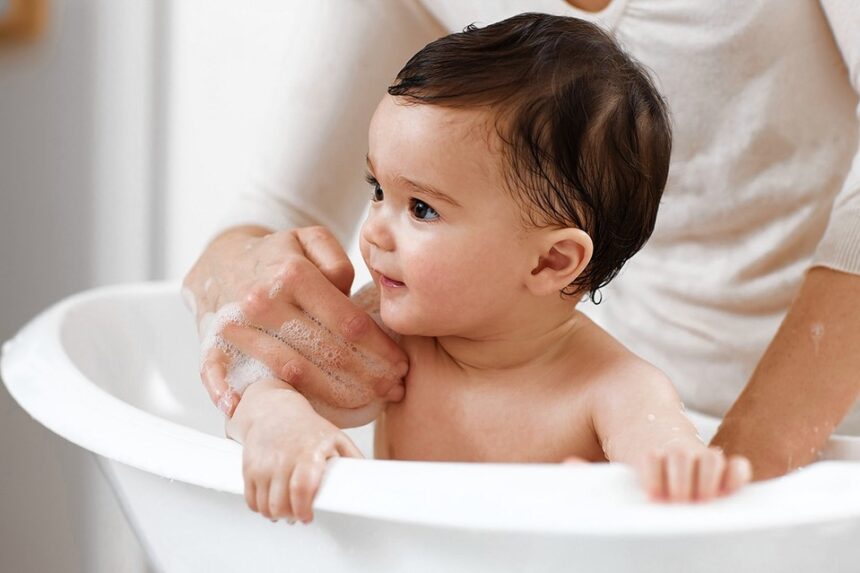Is your baby struggling with itchy, irritated skin? How do you make them more comfortable? Establishing a soothing routine can make a significant difference in managing eczema. Understanding the condition and implementing the proper care techniques can help alleviate your baby’s discomfort.
You can help your little one feel better from bath time to bedtime with the right approach. Products like baby eczema cream can provide much-needed relief and hydrate your baby’s skin. Let’s explore how to create an effective eczema-soothing routine for your baby.
Understanding Eczema in Babies
Common skin conditions like eczema can cause redness, itching, and dryness. Babies are particularly susceptible due to their sensitive skin. Recognising the signs early and implementing a soothing routine can prevent flare-ups and keep your baby comfortable. Understanding the triggers and proper care techniques is crucial in managing this condition effectively.
Eczema in babies often appears as patches of dry, scaly skin on the cheeks, scalp, and joints. It’s essential to monitor these areas and take note of any changes. By identifying potential irritants like certain fabrics, soaps, or even foods, you can better manage your baby’s eczema and reduce the frequency and severity of outbreaks.
Choosing the Right Bath Products
Gentle Cleansers
It’s crucial to avoid harsh chemicals and fragrances. These components have the potential to aggravate eczema symptoms and irritate delicate skin. Instead, opt for gentle, hypoallergenic products designed specifically for babies. This choice helps reduce the risk of irritation and maintains the skin’s natural moisture balance.
Importance of Moisturising
It acts as a barrier against dryness and retains moisture. An eczema cream right after the bath can soothe and hydrate your baby’s skin, preventing itchiness and discomfort. This practice is essential in keeping your baby’s skin healthy and well-moisturised.
Bath Time Tips
Optimal Bathing Temperature
Keep it lukewarm. While cold water might be uncomfortable, hot water can cause skin dryness. Aim for a temperature that feels warm on your wrist. This ensures the bath is soothing and safe for your baby’s delicate skin.
Bath Duration
Limit baths to 10-15 minutes. Extended submersion in water can deplete the skin of its natural oils, exacerbating the symptoms of eczema. A brief, gentle bath helps cleanse the skin without causing additional dryness. Keeping bath time short and sweet helps maintain your baby’s skin health.
After-Bath Care
Pat Drying
Using a gentle towel, pat the skin gently. Refrain from rubbing as this may aggravate delicate skin. Patting helps absorb excess water while keeping the skin calm and unagitated. This gentle drying method is critical to preventing post-bath irritation.
Applying Moisturisers
Right after drying. Applying baby eczema cream within three minutes of bathing helps lock in moisture effectively. This practice is essential in preventing dryness and keeping the skin healthy and supple. Consistent moisturising is vital in managing eczema symptoms.
Creating a Bedtime Routine
Comfortable Clothing
Dress your baby in soft, breathable fabrics like cotton. Steer clear of synthetic materials that can irritate and create perspiration. Ensuring your baby wears comfortable clothing prevents nighttime itching and promotes better sleep. Choosing fitting pyjamas can make a big difference in your baby’s comfort.
Maintaining a Cool Environment
Eczema can flare up if your baby gets too warm. Keep the room comfortably cool to prevent sweating and discomfort. A relaxed environment helps manage your baby’s eczema and promotes restful sleep. Adjusting the room temperature can significantly impact your baby’s skin health.
Nighttime Skin Care Tips
Regular Moisturizing
Frequently during the day, particularly in the hours leading up to bed. Consistent use of an eczema cream can keep the skin hydrated and reduce flare-ups. Maintaining a moisturising routine is critical to managing eczema effectively. Nightly moisturising can provide lasting hydration and relief.
Using Wet Wraps
Wet wraps involve wrapping the affected skin with a damp cloth followed by a dry one. This method helps the skin absorb moisture better, relieving severe eczema. Wet wraps can be particularly beneficial during flare-ups, offering soothing hydration. This technique can be a game-changer for severe cases of eczema.
Monitoring and Adjusting the Routine
Identifying Triggers
Keep a journal of flare-ups and potential triggers. This could include certain foods, fabrics, or environmental factors. Identifying and avoiding these triggers is essential for managing eczema. Understanding your baby’s unique triggers can help you tailor their care routine effectively.
Consulting with a Paediatrician
Consult a paediatrician if your baby’s eczema doesn’t improve with at-home care. They can provide additional treatments or suggest adjustments to your routine. Professional guidance ensures your baby receives the best possible care. A paediatrician can offer personalised advice and treatments.
Building an eczema-soothing routine for your baby involves thoughtful choices and consistency. Each step is vital in managing eczema, from selecting gentle bath products to maintaining a calm bedtime environment. Regular use of a baby eczema cream can significantly affect your baby’s comfort. By being attentive to your baby’s needs and adjusting their care routine as necessary, you can help them find relief and enjoy healthier skin. You may establish a calming habit that supports your child’s comfort and well-being with time and attention.






